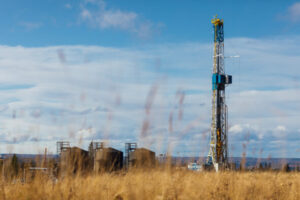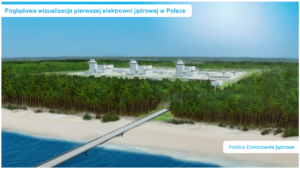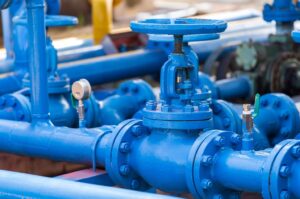Gazprom’s presence in the mining sector and gas infrastructure in Europe is becoming more and more troublesome, including the contested Nord Stream 2. However, the Russians are counting on new transactions that will allow them to reach for new assets – says Wojciech Jakóbik, editor-in-chief of BiznesAlert.pl.
Return of Catherine the Great
During the International Gas Forum in Petersburg, Gazprom’s CEO Alexei Miller met with the president of Verbundnetz Gas AG (VNG) Ulf Heitmuller on the expansion of the Katharina gas warehouse in Germany. Poles have expressed concerns about this cooperation. The response to this was the amendment of the EU regulation on security of supply (SOS).
Miller and Heitmuller talked about the expansion plan for the warehouse in eastern Germany. Currently, it uses six caverns and has a capacity of over 310 million cubic meters. After the gas has been injected into the seventh cavern at the turn of 2019 and 2020, the storage capacity will increase to over 350 million cubic meters. During the period of peak demand for gas, the gas consumption rate can reach up to 26 million cubic meters daily.
The cooperation of Gazprom at the Katharina gas warehouse raised the concerns of the Polish government, which BiznesAlert.pl informed first in 2015.
Verbundnetz Gas (VNG) and Gazprom have 50 percent of the joint venture of Erdgasspeicher Peissen GmbH. They invested 420 million euros in it. By 2024, twelve caverns for gas storage are to be built. Six of them are already in operation, which allows for the storage of approximately 614 million cubic meters of variable gas. Katharina is a name in honor of Catherine the Great, a Russian czarist born in Brandenburg. The warehouse is connected to the JAGAL gas pipeline with a connection of 38 km.
JAGAL combines the Yamal-Europe gas pipeline running from Poland with the transmission network under the control of the GASCADE operator. In the past, Poland has indicated that the priority of deliveries to Katharina may result in not enough capacity to bring gas through JAGAL to the reverse on Yamal and to Poland.
The influence of the Russian company on this infrastructure could have potentially meant that during periods of greater gas demand in Poland, the crisis mechanisms of supplies from Germany would not have worked, because the priority would be to inject Katharina. The SOS revision negotiated with the general participation of Poles responded to these fears.
– In the previous regulation on the security of gas supply, from 2010, we missed three decisions. First of all – ensuring the supply of so-called vulnerable customers (households, hospitals, emergency services, nursing homes, hospices, heating networks) in the situation of even the largest supply crisis. Secondly – regional cooperation in risk assessment, preparation of preventive actions and crisis plans. And thirdly – transparency of gas contracts with suppliers from outside the European Union, to give everyone equal opportunities in a competitive, common European market. All these three weaknesses have now been resolved – explained in an interview with BiznesAlert.pl MP Jerzy Buzek, who was the rapporteur of the draft revision in the European Parliament.
Business symbiosis with Russia
Recently, it turned out that Gazprom will not take over shares in further European assets. OMV will buy shares in Siberian Urengoy deposit from it, but in return will not give up shares in OMV Norge AS operating in Norway. According to Reuters, the transaction was blocked by Oslo.
– Discussions on the exchange of assets have lasted for several years, the last option was that for the shares in two blocks of the Urengojskie OMV field, Gazprom would have a stake in its Norwegian assets. Gazprom and OMV agreed on this at the end of 2016. However, from the very beginning it was obvious that it was not on the way Oslo: delay in issuing consent was justified once by the approaching elections, sometimes by procedural issues. Recently, the Minister of Oil was probably talking about his doubts connected with the transaction – explains Agata Łoskot-Strachota from the Center for Eastern Studies.
– There seem to be at least two reasons here: on the one hand, Gazprom is a direct competitor of the Norwegian supplier on the European market. On the other hand, Norway may be afraid of a patch that has adhered to Gazprom and probably builds its image in the EU to a certain extent against its counterpart, presenting itself as a safe, reliable and stable supplier.
– It is worth remembering that Russian investors already have shares in the Norwegian shelf, and the finalization of the Wintershall-DEA merger will increase their access to the Norwegian mining sector to some extent – emphasizes the OSW analyst.
A similar exchange of assets may take place between German BASF and the Russian LetterONE. In exchange for the creation of a joint venture between DEA (owned by Letter One) and Wintershall (BASF’s daughter companies), the shares in GASCADE, a joint venture between Gazprom and Wintershall, which is the operator of the planned Nord Stream 2 gas pipeline in Germany, would be purchased. Wintershall is already the financial partner of the disputed project. The asset exchange between BASF and LetterOne is waiting for the green light to be received in mid-2019.








